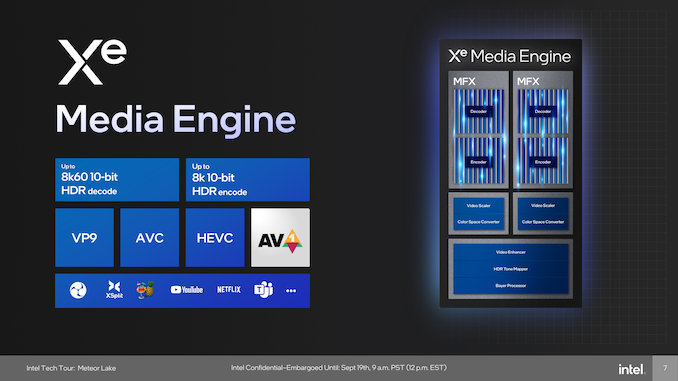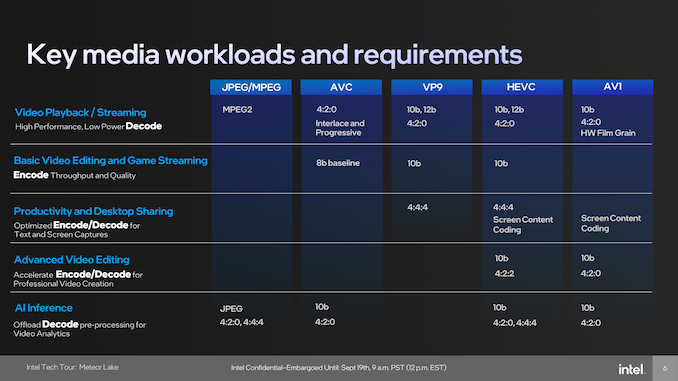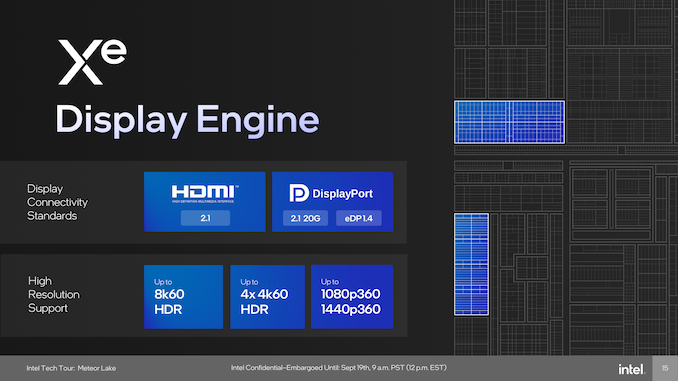Intel Unveils Meteor Lake Architecture: Intel 4 Heralds the Disaggregated Future of Mobile CPUs
by Gavin Bonshor on September 19, 2023 11:35 AM ESTSoC Tile, Part 3: Disaggregating Xe Media and Display Engine From Graphics
As we noted earlier, Intel has completely redesigned its graphics, media, and display engine for Meteor Lake and, as such, separates all three entities from each other. While we'll cover the new graphics tile next, we'll start with everything that's not part of the graphics tile. Opting for a disaggregated architecture allows Intel to not only shuffle things around from an IP perspective but also allows Intel to integrate new IPs such as cores, graphics, and I/O as and when advancements have been made at a silicon level, but the design allows unties Intel from being limited to a specific manufacturing process.
Starting things off, we have the Xe Media Engine, which is embedded within the SoC tile. Within the Xe Media Engine are two Multi-Format Codecs (MFX), designed and responsible for all the encoding and decoding tasks. Intel's Meteor Lake with Xe supports the latest codecs ranging from AV1 (decode and encode), HEVC, AVC, and VP9, with up to 8K60 HDR decode supported. For encoding, there's support for up to 8K resolutions with 10-bit color and HDR. Aiming to improve power efficiency on-chip with encode/decode workloads, having a dedicated Media Engine separate from the graphics allows Intel to find granular power savings as things are directed to the Xe Media Engine, which means the graphics tile doesn't need to be powered up to accomplish encode or decode tasks.
The Xe Media Engine provides various functionalities across a large spectrum of different video codecs. This ranges from JPEG/MPEG and AVC to the more advanced VP9, HEVC, and AV1 codecs. Designed to give Meteor Lake a solid level of computational efficiency for video processing, the Xe Media Engine balances the gaps between high-performance output and power efficiency, rendering it particularly well-suited for various applications, from real-time video streaming to high-fidelity playback. There's also support for diverse color formats and bit depths, including but not limited to 4:2:0 at 10-bit and 12-bit, which means it's versatile for video editing and video encoding and should satisfy content creator's needs.
Xe Display Engine: Also Within the SoC
Much like the Xe Media Engine, the Xe Display Engine is also found within the SoC tile on Meteor Lake. Decoupling this directly from the graphics tile and embedded into the SoC allows it to communicate directly with the Xe Media Engine, saving power and improving overall battery life. The engine supports up to four display pipes, two of which have been designed and optimized for low power consumption, further boosting overall efficiency for Meteor Lake.
Looking at compatibility, the Xe Display Engine looks to use the latest connections and ports, including native support for HDMI 2.1, DisplayPort 2.1, Embedded DisplayPort (eDP) 1.4. and even DSC 1.2a. Via these blocks, Meteor Lake can support displays up to 8K60 HDR, or up to 4 x 4K60 HDR displays, and this is on top of 1080p360 and 1440p360 too. This gives Meteor Lake substantial display and multimedia device support, including current and up-and-coming panels.













107 Comments
View All Comments
FWhitTrampoline - Thursday, September 21, 2023 - link
That would be more of DIY friendly Very Small Form Factor Enthusiast/end user there! And with a reasonable expectation that the vibrant DIY Small Form Factor devices(Mini desktop PCs) market continue to be offered Socket Packaged Processors with newer than Ryzen 5000G/Zen-3 and Vega 8CU iGPU based graphicsIP, and Ditto for any Intel based options as well.
So it's wrong to expect any Further Ryzen G series Desktop[Socket Packaged] APUs from AMD because that's not good for the OEMs there and their business models that are not so DIY friendly for Processor Upgrades if the Processor comes BGA wedded to the Motherboard! And OEM products that are not so good for eWaste reduction because if the processor goes that can not be easily replaced/upgraded by the end user(DIY sorts of Folks).
There needs to be a Right to Processor Upgrade just as much as a Right to Repair and with Socket packaged processors those rights go hand in hand there along with any environmental eWaste concerns. But we must not trample upon those Business Models as that's just not good for OEM Profits there, consumers be damned!
And InWin Chopin or ASRock Desk Mini, Socket Packaged APUs/SOCs are the best option as that's by definition DIY friendly there.
I'll expect no Complaints from you if the entire PC market goes BGA Packaged Processors only and you'll have to buy the Processor Attached to the Motherboard, take it or leave it!
brucethemoose - Wednesday, September 20, 2023 - link
> That might make a really nice media playerSeems like a lot of silicon for what's essentially the job of a dirt cheap ARM SoC. And its a questionable fit for a headless system unless its like a stable diffusion/transcoding host.
It *does* seems like an interesting fit for a smart TV chip, maybe with a small GPU die, as they would actually use the NPU for their internal video filtering.
emvonline - Tuesday, September 19, 2023 - link
Intel 4 will not be shipping any products to customers until Mid December. This after stating it is in production in December 2022. 12 months from production starts to PCs out is not good. And I better be able to buy meteor lake Notebook on Dec 14th 2023 or this is exactly like old Intel (Launch means we may have sold some parts to someone somewhere). This claiming a node is done when its production ready, when you ship nothing is problematic. FYI Meteor Lake is 2x the cost of Raptor lake in 2024. Intel 4 is not a cost reduction. The product might be great but it is expensiveRoy2002 - Tuesday, September 19, 2023 - link
4 was in production in December 2022? No way! It should be started not long ago.Usually the first real product silicon would be taped out one year ahead of release date. And that silicon would be very buggy and needs several steppings to have bugs fixed.
Roy2002 - Tuesday, September 19, 2023 - link
So December 2022 is the initial project tapein date and silicon debug follows.ChrisGar15 - Tuesday, September 19, 2023 - link
Probably called "manufacturing ready."xol - Wednesday, September 20, 2023 - link
So Xe-lpg is still intel uhd graphics (13\14th gen now?) with top EU count of 128 up from 96. Fine.maybe about 3TF fp32, not quite xbox Series S level
They added RT support which is good i guess but will it ever be used in a gpu that is really PS4 performance?, or maybe there are not gaming applications.
product sounds good, just wait for the numbering scheme
JBCIII - Wednesday, September 20, 2023 - link
"An example of how applications pool together the various tiles include those through WinML, which has been part of Microsoft's operating systems since Windows 10, typically runs workloads with the MLAS library through the CPU, while those going through DirectML are utilized by both the CPU and GPU."This sentence is really a mess. Editor: please take note. Is "example" the subject of "include"? That would make "includes" the necessary form of the verb. What is the subject of "runs"? I'm guessing WinML. Maybe it should be "WinML...which typically runs" but the long parenthetical expression about Windows 10 support makes it hard to bridge the gap. Maybe parentheses would be more clear instead of commas to keep the meaning on track. I'm still not sure what was meant.
GeoffreyA - Thursday, September 21, 2023 - link
WinML is the higher-level abstraction, and DirectML, the lower-level one.Kevin G - Wednesday, September 20, 2023 - link
This is what I was hoping to see Intel pull off in the late 14 nm/early 10 nm days when their foundries were having difficulties. Intel should have pivoted int his direction at the first sign of trouble with those as the packaging side of this, while cutting edge back then, could have been pulled off. Better late than never.However with Meteor Lake around the corner, it is shaping up to a pretty good design. Both the CPU and GPU sides can scale and evolve independently from the central SoC. The GPU portion that was moved onto the SoC makes sense as the codecs and display logic are not going to change over the next few generations. I would quibble about the point made that putting them next to the NPU is more advantageous than next to the GPU cores. There certainly is a benefit for AI upscaling of movies but my presumption is that I'd be lower power/lower latency to have the encoders next to the GPU cache which houses the final render frame for encoding and transmission. The tasks that's benefit here would be gaming streaming or remote access. Both things can be true hence why it is a quibble as it'll matter to individual use cases which one approach is superior.
My initial presumption for the IO die was that it was to house various analog circuits that would then be leveraged by the SoC die. This is a clever means of process optimization as analog circuitry does not scale at the same rate as logic. Similarly this would permit a cheaper die to extend the number of area intensive IO pads.
The last thing missing is the L4 cache die that was hinted at in earlier Linux patches. That'll probably come along with the Lunar Lake generation.